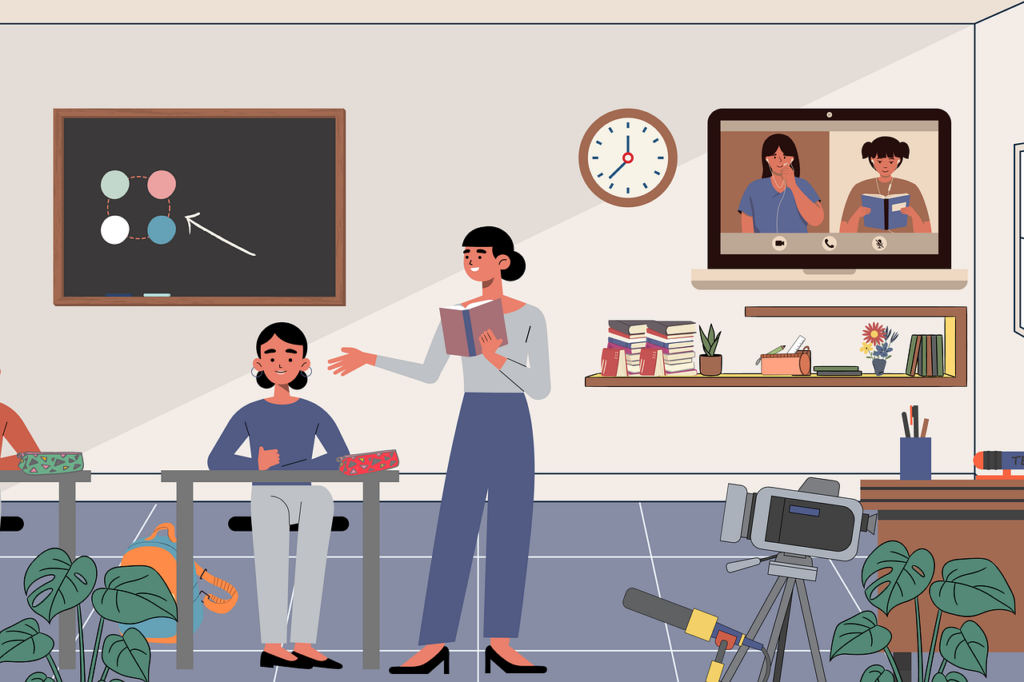
Lesson Plan: Why We Pause for People
Materials:
- Slides (5-10)
- “Why We Pause for People” video
- Active Listening Tips handout
- Crossword puzzle (Part 2 of the handout)
Digital Tools:
- Google Slides
- YouTube
- Seesaw
- Kahoot!
Multiple Means of Engagement
- Watch (Video): “Why We Pause for People”
- Display images on Slide 5.
- Ask: “What about the similarities and differences between these two pictures?”
- Have students share their observations.

Peer Discussion:
- Discuss the importance of active listening (Slide 6).
- Ask: “Why do you think active listening is an important skill to practice?”
- Explain: Active listening shows respect and helps others feel understood.
- Use Seesaw for students to record and upload their discussions.
Poetry incorporation:
- Discuss the limerick from the video (Slide 7).
- Read the limerick together as a class (Slide 8).
- Encourage students to think about the poem’s message.
Multiple Means of Representation
- Distribute the Active Listening Tips handout.
- Have students complete Part 1 individually or in pairs (Slide 9).
- Use Seesaw for students to upload their completed handouts or digital responses.
Class Discussion:
- Invite students to share their ideas from the handout.
- Use the Teacher Version to highlight key active listening tips.
- Discuss how active listening should look when devices are used in the classroom.
- Encourage reflection by saying: “Active listening is more than just hearing words. It’s about showing that you care and are trying to understand.”
- Use Seesaw for students to submit written or recorded responses.
Multiple Means of Action and Expression
- Complete the crossword puzzle on Page 2 of the Active Listening Tips handout (Slide 10).
Creative Activity (Extension):
- Have students create their limericks about active listening.
- Provide options for students to write or draw their ideas.
- Complete the crossword and upload it to Seesaw.

Assessment:
- Observations during group sharing and class discussion.
- Complete the Active Listening Tips handout or the crossword puzzle.
- Create a Kahoot quiz to review the concepts learned about active listening and device use.
- Include questions where students identify good listening behaviors, benefits of active listening, and examples of distractions.
Triple E Evaluation: Redesigned Lesson Plan
Engagement:
The redesigned plan enhanced engagement by integrating Seesaw for recording and uploading discussions, and Kahoot for interactive quizzes. These tools provide various ways for students to engage with the content, catering to different learning preferences.
Enhancement:
Seesaw and Kahoot provided interactive elements that make learning more engaging and help students better understand the concepts. Using multimedia (videos, images, audio) in Seesaw allows for a richer learning experience. These activities encourage students to apply, critical thinking skills rather than just remember and understand.
Extension:
The redesigned plan extends learning beyond the classroom by using Seesaw to facilitate asynchronous engagement and reflection. This allows students to connect their learning to their real-life experiences. For example, creating and sharing their limericks on Seesaw connects the lesson to real-world activity, making learning more meaningful.
Reflection:
The original lesson plan was created to teach students the importance of active listening and the impact of device use on attention. The redesigned lesson plan was designed around UDL principles with digital tools like Seesaw and Kahoot to enhance engagement, representation, and expression. The original lesson plan is well-organized with a clear sequence of activities. It includes watching a video, discussing images, reflecting on a poem, and completing a handout. Its weaknesses are that it lacked digital tools, and engagement primarily relied on verbal and written activities, which doesn’t cater to all learning styles. The original lesson doesn’t address the needs of diverse learners. It should include assistive technologies or alternative ways to demonstrate understanding.
In the redesigned plan using UDL principles, I integrated Seesaw for recording and uploading discussions and reflections, and Kahoot for interactive quizzes. The tools help to support and increase student engagement. They provide various ways for students to access and understand information. Students will use Seesaw to submit verbal discussions, written responses, and creative projects. This approach caters to different learning preferences and abilities. The redesigned lesson plan’s weaknesses are time constraints, training, and possibly accessibility for all classrooms let alone students. Technology requires time and training to be properly integrated. It aids and enhances lesson plans yet administrators are not prioritizing allotting time to ensure the teacher and students are trained to use and understand the technology.
In conclusion, while the original lesson plan was well-designed and organized, the redesigned plan incorporating Seesaw and Kahoot improves engagement, representation, and accessibility. It made the lesson plan a more inclusive and effective learning activity.
Sources:
JUNG, L. A. (2021, July 1). Lesson Planning with Universal Design for Learning. ASCD. https://ascd.org/el/articles/lesson-planning-with-universal-design-for-learning
Lesson Evaluation and Redesign. (n.d.). Universal Design for Learning. Retrieved July 13, 2024, from https://udlhcpss.weebly.com/lesson-evaluation-and-redesign.html
Posey, A. (2022). Universal design for learning (UDL): A teacher’s guide. Understood. https://www.understood.org/en/articles/understanding-universal-design-for-learning
Triple E Evaluation Rubric for Lesson Design. (n.d.). Triple E Framework. https://www.tripleeframework.com/triple-e-evaluation-rubric-for-lesson-design.html



